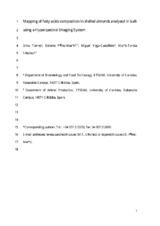Mapping of fatty acids composition in shelled almonds analysed in bulk using a Hyperspectral Imaging system
Autor
Torres, Irina
Pérez-Marín, D.C.
Vega-Castellote, Miguel
Sánchez, María-Teresa
Editor
ElsevierFecha
2021Materia
Shelled almondsHyperspectral imaging
Fatty acid mapping
Non-destructive analysis in bulk
METS:
Mostrar el registro METSPREMIS:
Mostrar el registro PREMISMetadatos
Mostrar el registro completo del ítemResumen
The determination of the fatty acid profile in food products is an important issue, as it serves as a guide to consumers who wish to follow healthy diets. Hyperspectral Imaging (HSI), permits rapid, non-destructive quality evaluation in foods by integrating the spatial dimension of the composition distribution. The aim of this research was to measure the fatty acid profile of almonds using HSI in 149 samples of shelled sweet and bitter almonds. In addition, we analysed the inter- and intra-kernel distribution of fatty acids for both type of almonds. Shelled sweet and bitter almonds were scanned in bulk by reflectance HSI (946.6–1648.0 nm) and then analysed by gas chromatography to determine their fatty acid composition. Next, we built quantitative prediction models using Partial Least Squares (PLS) regression and tested two validation strategies — mean spectrum and pixel-by-pixel. The developed HSI calibration models showed a good performance when quantifying oleic and linoleic acids, while the models developed could be used for screening purposes for the rest of the fatty acids analysed and for the oleic to linoleic ratio. The results obtained confirm that HSI can be considered a promising approach for estimating fatty acids and their inter- and intra-kernel distribution.

